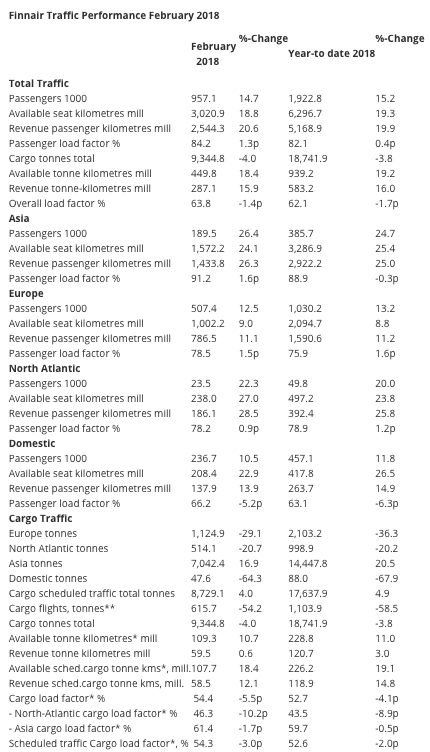In February, Finnair carried 957,100 passengers, or 14.7% more than in the corresponding period of 2017. The number of passengers grew the most in Asian traffic, 26.4%, but growth was also strong on North American routes (+22.3%), European flights (+12.5%) and in domestic traffic (+10.5%).
Finnair's overall capacity measured in Available Seat Kilometres (ASK) increased in February 18.8% year-on-year. Finnair's traffic measured in Revenue Passenger Kilometres (RPKs) grew by +20.6%, driven by the increased demand for long-haul leisure travel. The Passenger Load Factor (PLF) in total traffic increased by 1.3 %-points to 84.2%.
In February 52% of Finnair's ASKs were in Asian traffic, 33% on European routes and the rest in North American and domestic traffic. Finnair’s long-haul capacity was increased mainly by the A350 aircraft introduced after the reference period. In contrast to the comparison period, we flew also to Chongqing in February, and added frequencies especially to Bangkok, Hong Kong and Singapore. Additional capacity was also allocated to new seasonal routes to Goa, Puerto Plata, Puerto Vallarta and Havana, which replaced Varadero that was operated in the reference period. The ASK growth in Asian traffic was 24.1% and in North American traffic 27.0%. The 9.0% ASK growth in European traffic derived from the increase in the narrow-body fleet size year-on-year and the additional seating capacity added to some if its existing narrow-body aircraft. Capacity growth was directed at serving the new year-round destination Reykjavik, added frequencies especially to Stockholm, Copenhagen and Berlin and direct flights to Lapland from Paris, London and Zurich. The significant ASK growth in domestic traffic, +22.9%, reflects added capacity to destinations in Northern Finland.
RPKs grew 26.3% in Asian traffic, 28.5% in North American traffic, 11.1% in European traffic and 13.9% in domestic traffic. The PLF was 91.2% in Asian traffic, 78.2% in North American traffic, 78.5% in European traffic and 66.2% in domestic traffic. The PLF in total traffic increased by 1.3 %-points to 84.2%.
Available Scheduled Cargo Tonne Kilometres increased by 18.4% year-on-year. Revenue Scheduled Cargo Tonne Kilometres increased by 12.1%. Finnair’s total cargo capacity also included three weekly freighter flights between Helsinki and Brussels, operated by DHL. Cargo flight volumes decreased from the comparison period, when Finnair rented cargo space from Japan Airlines. Finnair’s new COOL Nordic Cargo terminal was taken in full use in January.
Difficult winter conditions at Finnair's home hub Helsinki-Vantaa and in many other European hubs caused several delays and cancellations in the beginning and end of the month. In February 72.3% of all Finnair flights arrived on schedule (83.5).
Traffic statistics for March 2018 will be published on Tuesday, 10 April 2018.

